Effectiveness of Different Polymer like Shielding Materials and Thicknesses for Radiation
Info: 8291 words (33 pages) Dissertation
Published: 16th Dec 2019
Tagged: Sciences
It is difficult to simulate and complex to describe the interaction of space particles with airborne electronics and materials using ground-based test facilities. Furthermore, it is impossible to fully specify the space radiation environment for a given mission because of unknowns in mapping it and unknowns in the process that generates it. It is also a challenge to completely assess the hazards at any altitude and latitude because the space radiation environment changes with time, often in unpredictable ways.
The majority of the effects of radiation are known and can be experimented with in flight experiments and in developed laboratories. However, it is critical to have the ability to protect air vehicles from radiation to help reduce its risks. The shielding material choice is a major part of the design. Figure 4.1 illustrates the basic radiation shielding process.

The focus of the proceeding experiment demonstrates the effectiveness of different polymer like shielding materials and thicknesses. Among all the types of radiation, this work involved gamma ray and neutron radiation.
This experiment general idea is focused on finding the effectiveness of blocking the ionizing radiation using different materials and thicknesses. The word ionizing refers to the ability to ionize a molecule or an atom of the medium it traverses. Ionizing radiation includes Gamma rays, X-rays and all the atomic and subatomic particles that are available in the space environment such as neutrons, alpha particles, protons, heavy ions, etc. The ionizing radiation can be generally classified into two principle types; one is directly ionizing radiation, which includes radiations of energetic particles carrying an electric charge like alpha particles, protons, beta particles and other recoil nuclei. They cause ionization by direct action on electrons in atoms of the media through which they pass. X-rays, neutrons and Gamma ray photons are classified as indirectly ionizing radiation. These are not charged and they use a more complicated mechanism to cause ionization, involving the emission of energetic secondary particles, which cause most of the ionization [30]. Directly ionizing radiation is easily stopped because it interacts strongly with shielding media. On the other hand, indirectly ionizing radiation may be quite penetrating. Therefore, the shielding required may be expensive and quite massive [30]. Figure 4.2 illustrates the interaction of ionizing radiation with matter.
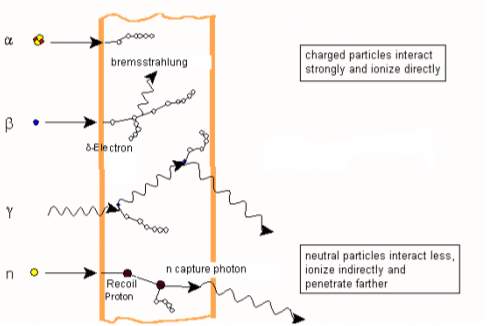
Initially, many different types of radiation sources were looked at. Alpha, gamma and beta radiation sources are valid options that are prevalent in the space environment. A gamma radiation source was the most plausible because of its higher energy and more occurrences in the space environment. Additionally, in this experiment, attention was given to indirect ionizing radiation. However, obtaining a gamma radiation source that could be used in ground based facilities at an affordable cost proved to be a challenge. Another restriction was safety and ease of obtaining. Because of the long-term dangers of radiation exposure, there are many restrictions on ordering and storing radiation on campus. After some research, a radiation supplier was found.
The radiation source used was a series of radium-226 coated clock hands that emits gamma radiation with a mean particle energy of 0.186 MeV.Ra-226 is a radioactive substance found in nature. In1898, Pierre and Marie Curie discovered radium while conducting research with uranium ore. The radioactive decay of uranium-238 enabled the forming and production of Ra-226. Radioactive decay takes place because certain atoms are unstable and need to release energy in an attempt to become stable. Energy is released when Ra-226 decays in the form of rays (gamma rays) and particles. Our senses cannot detect this energy (radiation) therefore special instrumentation such as Geiger Counters (GCs) is required to perform such detection task.
As mentioned earlier, Geiger Counters are used to measure the dosage of radiation. The Geiger Counter used in this experiment is presented in Figure 4.3.
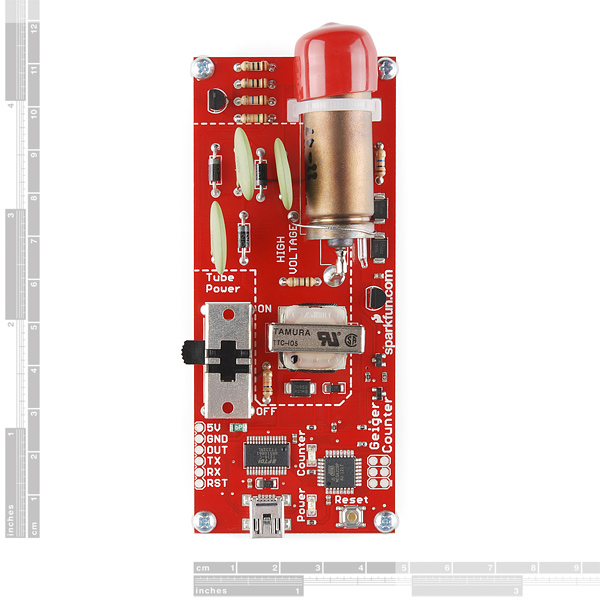
The GC is powered through a USB cable that is connected to a power supply (the switch must be in the ON position). A red light flashes during each bit generation (0 or 1). Each one represents an actual event in the tube in the real time, so the output can be used to deduce the CPM (counts per minutes). A separate computer was programmed using an Arduino board to read the input bit and turn it into an output of the total number of counts in ~60000 milliseconds. An example of the background radiation counts in a total time of ~ 6 min is presented in table 4.1.
| Counts | Time interval (ms) | Total time elapsed (ms) | CPM |
| 11 | 61214 | 78872 | 10.78 |
| 18 | 61233 | 145659 | 17.64 |
| 11 | 60978 | 212158 | 10.82 |
| 15 | 63706 | 297603 | 14.13 |
| 16 | 62942 | 362179 | 15.25 |
The Geiger tube comes with a red boot to protect the end window during production, handling, and shipping. The boot is removedto detect alpha particles. However, in this experiment, our concern is to see activity from gamma radiation. Therefore, the boot was applied during the experiment.
The first consideration in choosing a shielding material must be its effectiveness. A shield is considered effective if it causes a large energy loss in a relatively small penetration distance without emitting more hazardous radiation. Factors that may influence the choice of shielding materials include weight of the material, cost of the material, and how much space is available for the material. The interactions between the incident radiation and the atoms of the absorbing medium determine the effectiveness of the shield. These interactions depend mainly upon the energy of the radiation, the type of the radiation and the atomic number of the absorbing medium. Figure 4.4 shows some radiation shielding materials that are typically used.

Many different “plastic like” and carbon based materials have been tested for their effectiveness in radiation shielding. The suitability of these different materials depends not only on whether they are being tested for direct versus indirect radiation, but also on the purpose of the shielding, its duration and the object to be shielded (for example a human being, sensitive electronic equipment, or general equipment). Some properties that may influence material selection in electronic equipment protection include the effectiveness of attenuation (how much radiation it can block either by blocking it or by bouncing the energetic particles through a barrier), material strength, resistance to radiation and mechanical damage, and thermal properties [33].
Some of the advantages of using plastic-like materials and polymers in radiation shielding of electronics include their high hydrogen atom content, low density compared to metals such as lead and aluminum, and the fact that they are solids at room temperature (water, which is also an effective shielding agent, is in liquid form). In addition, polymer-embedded nanostructures are potentially useful for a number of technological applications, especially as advanced functional materials for high-energy radiation shielding and as microwave absorbers. While major interaction processes of these materials at low energies (< 1000 keV) are incoherent or Compton scattering, coherent or Rayleigh scattering and atomic photoelectric effect absorption, the processes at higher energy levels above 1000 keV include nuclear-field pair production and atomic field triplet production [34]. The former group of effects are more important in this case since, as discussed previously, gamma radiation with a mean particle energy of 0.186 MeV was used in this experiment.
The relative dominance of these effects is measured using the gamma-ray mass attenuation coefficient of a material, with photoelectric effects dominating below 1 MeV, Compton scattering at 1 MeV, and pair production above 1 MeV. It has been reported that polyvinyl chloride (PVC) exhibits the highest mass attenuation coefficient value in the energy range 10-110 keV, which is even higher than that of concrete, while another plastic material, Radio Chromic Dye Film, exhibits superior attenuating (shielding) behavior in the range 110-1400 keV [34]. Concrete, which is denser than most plastics, has higher values of total linear attenuation coefficients in the range 10-1400 keV. In comparison, aluminum is not as effective against gamma radiation as lead or concrete [35]. The shielding effectiveness of all materials, however, depends on their densities. As a result, the mass attenuation coefficient may be more important in deciding the shielding effectiveness of a material, and this is the reason that plastic materials may be more effective if adequate thickness is provided for protecting electronic components.
Another issue in assessing the effectiveness of plastic materials as radiation shields is radiation-induced effects, since exposure to radiation causes deleterious effects on properties of many materials. For example, changes in the properties of steels and other metals exposed to high-energy radiation include lower yield stress, tensile strength, hardness, decreased ductility, and toughness. Radiation has similar detrimental effects on the behavior of plastics. For example, both polyethylene (PE) and borated PE have been observed to exhibit significant degradation in terms of thermal and mechanical stability when exposed to continuous irradiation [36].
Three plastic materials were used in the present experiment: Polylactic Acid or polylactide (PLA), Acrylonitrile-Butadiene-Styrene (ABS) and High Impact Polystyrene (HIPS). PLA is a thermoplastic polymer (can be heated to their melting point, cooled, and re-heated again without significant degradation) derived from renewable resource (bioplastic), as opposed to traditional plastics which are derived from the distillation and polymerization of nonrenewable petroleum reserves. The material has several different types including PLLA, PDLLA and PDLA, each has slightly different characteristics. PLA has similar characteristics to polyethylene (PE) and polypropylene (PP). The material production fulfills the dream of cost-efficient as it can be produced from already existing manufacturing equipment like those designed and originally used for petrochemical industry plastics, which makes its production volume the largest of any bioplastic. PLA is commonly available as a 3D printable filament in a myriad of colors. It is one of the two common plastics used in molding manufacturing processes on Fused Deposition Modeling (FDM) machines. ABS is the other common 3D printing plastic. The material is mainly made through two different processes; condensation and polymerization. The usual polymerization technique is known as ring-opening polymerization, which is a process that uses metal catalysts in combined with lactic acid to produce the larger PLA molecules. Condensation process is similar with the main difference being the temperature during the procedure and the condensates released as a result of the reaction [37]. Some of the properties of PLA are shown in Table 4.2 below.
| Property | Value |
| Technical Name | Polylactic Acid (PLA) |
| Chemical Formula | (C3H4O2)n |
| Melt Temperature | 157 – 170 °C (315 – 338 °F) |
| Typical Injection Molding Temperature | 178 – 240 °C (353 – 464 °F) |
| Heat Deflection Temperature (HDT) | 49 – 52 °C (121 – 126 °F) at 0.46 MPa (66 PSI) |
| Tensile Strength | 61 – 66 MPa (8840 – 9500 PSI) |
| Flexural Strength | 48 – 110 MPa (6,950 – 16,000 PSI) |
| Specific Gravity | 1.24 |
ABS is an amorphous polymer and opaque thermoplastic. The material has a strong resistance to corrosive chemicals and physical impacts. Likewise, PLA, ABS is easily machined, and particularly simple for 3D printing and relatively cost effective. Therefore, ABS is being used in a huge number of applications. The material is very structurally robust, which makes it used in things like protective housings, camera housings and packaging. ABS is usually polymerized through the process of emulsion. ABS is also made, although less commonly, by a process called continuous mass polymerization. Generally, the most common methodology to create ABS is through emulsion [38]. Some of the properties of ABS blends are shown in Table 4.3 below.
| Property | Value |
| Technical Name | Acrylonitrile butadiene styrene (ABS) |
| Chemical Formula | (C8H8)x· (C4H6)y·(C3H3N)z) |
| Glass Transition | 105 °C (221 °F) |
| Typical Injection Molding Temperature | 204 – 238 °C (400 – 460 °F) |
| Heat Deflection Temperature (HDT) | 98 °C (208 °F) at 0.46 MPa (66 PSI) |
| Tensile Strength | 46 MPa (6600 PSI) |
| Flexural Strength | 74 MPa (10800 PSI) |
| Specific Gravity | 1.06 |
The polymer HIPS can be manufactured and machined easily at low costs. It is actually a blend of polystyrene and polybutadiene where the latter has a lower concentration (2-8mol %), prepared in such a way that the substance possesses enhanced impact properties. This is ensured by the polybutadiene introduced before the free radical polymerization of styrene – the polybutadiene nodules are then compatibilised by grafting of styrene units so that there is lower degradation of the product [39]. Properties of the polymer are shown in Table 4.4.
| Property | Value |
| Technical Name | High Impact Polystyrene (HIPS) |
| Chemical Formula | (C12H16)N |
| Melt Temperature | 210-249 °C (410-480 °F) |
| Typical Injection Molding Temperature | 38 – 66 °C (100 – 150 °F) |
| Heat Deflection Temperature (HDT) | 95 °C (284 °F) at 0.46 MPa (66 PSI) |
| Tensile Strength | 53 MPa (7700 PSI) |
| Flexural Strength | 83 MPa (12000 PSI) |
| Specific Gravity | 1.04 |
As discussed earlier, using a higher density material or increasing the thickness of the shielding material are effective strategies when considering gamma ray shielding for electronic equipment. Therefore, a series of experiments were performed in which each of the materials was used in layers of increasing thickness so that the effective thickness was increased.
The background radiation measured using the Geiger counter in the absence of radiation source or shield is shown in Figure 4.5. The average count per minute (CPM) for background radiation in this case was 13.
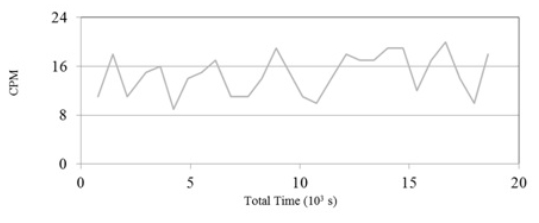
The background radiation measured using the Geiger counter with a radiation source but with no shield is shown in Figure 4.6. The average count per minute (CPM) in this case was 451.
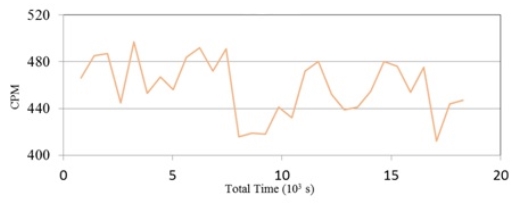
Measured CPM values for four materials – ABS (black), PLA (blue), HIPS (red) and ABS+PLA (purple) – are shown in Figure 4.7. The shielding thickness of materials was doubled each time from 2 mm to 4 mm to 8 mm to 16 mm. It can be observed that each doubling of thickness reduces CPM – for example in case of ABS (black line) the averaged CPM value decreased from 265 (2 mm) to 229 (4 mm) to 171 (8 mm). Similarly, in the case of HIPS (red line) the averaged CPM value decreased from 276 (2 mm) to 215 (4 mm) to 166 (8 mm) to as low as 125 (16 mm, shown in the bottom panel). The graphs also show considerable variations in CPM counts over time – in particular, a spike in CPM for HIPS having thickness 2 mm (top panel), indicating ineffectual shielding for that thickness.
However, the considerable overlapping of the black and blue lines in the top three plots indicates that there is no significant difference between ABS and PLA. The bottom graph only shows two materials – HIPS at 16 mm (red) and a combination of two sheets of PLA and ABS of thickness 8 mm each (purple) because, as can be observed in the graphs, although there is no practical difference in shielding ability between ABS and PLA there is some difference in the case of HIPS. It can be observed that increasing the shielding thickness not only reduces CPM for all four materials but also decreases fluctuations. This is desirable for electronic equipment, which may otherwise get damaged from a single, randomly high exposure incident. Some of the variations in CPM observed in these figures can be attributed to fluctuating background radiation events.

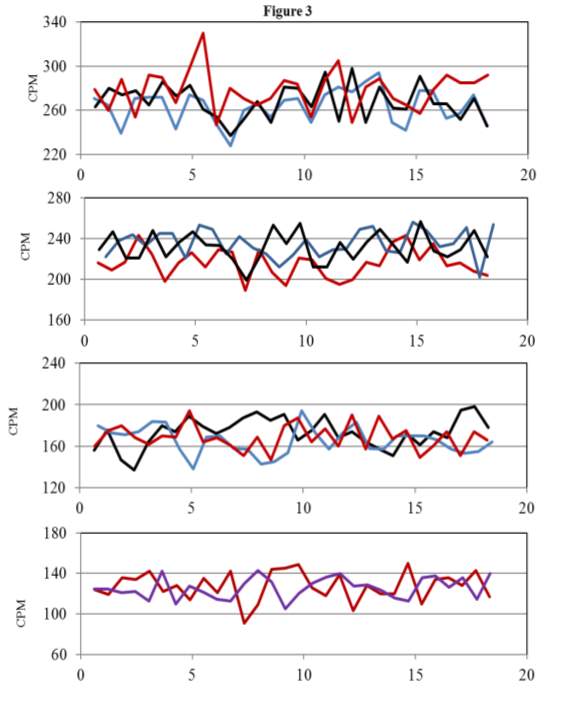
- Values of CPM with elapsed time (in units of 103s) for four shielding thickness values, top to bottom 2 mm, 4 mm, 8 mm, and 16 mm
The effectiveness of aluminum as a shielding agent is shown in Figure 4.8. Two different thicknesses are shown, 2 mm and 4 mm, depicted by light blue and dark blue lines respectively. The average CPM for aluminum is lower than for the plastic materials for equivalent thickness – 218 and 203 respectively – suggesting that it is a more effective shielding agent when equivalent thicknesses are used. However, as observed in Figure 4.7 earlier, HIPS and PLA have comparable effectiveness when thicker layers of these materials are used. This suggested that HIPS and PLA, which are more flexible and cost-effective, can be as good (or better) electronic shielding agent as aluminum if higher thickness is used.
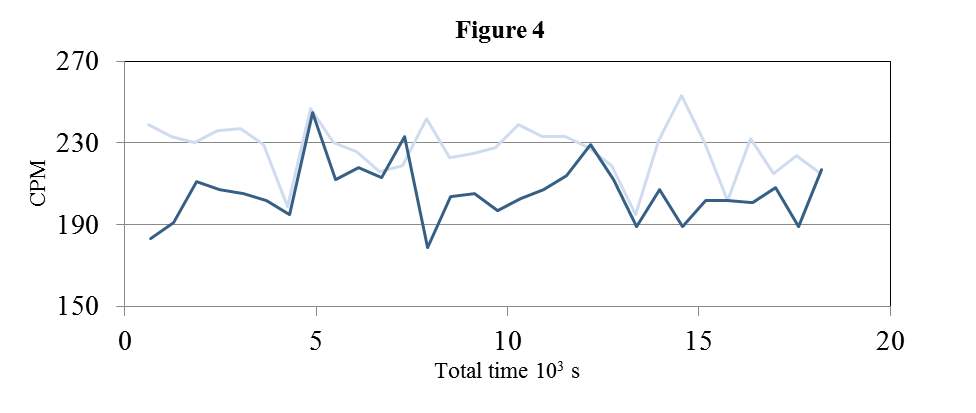
The effectiveness of all materials in the experiment is presented in Figure 4.9 in terms of their R values, where R is the ratio of the average CPM for a given material of given thickness and average CPM with no shield (R= CPMavg/CPM0). Therefore, R is a measure of the effectiveness of the material having the specified thickness. A correction was also incorporated in the graph by subtracting the background radiation value of 13 (correction factor = CPMavg – 13) so that the effect of the shielding against Gamma rays could be shown more clearly. A combination of ABS and PLA is shown because it was earlier determined that this pair has a different shielding effectiveness than HIPS.

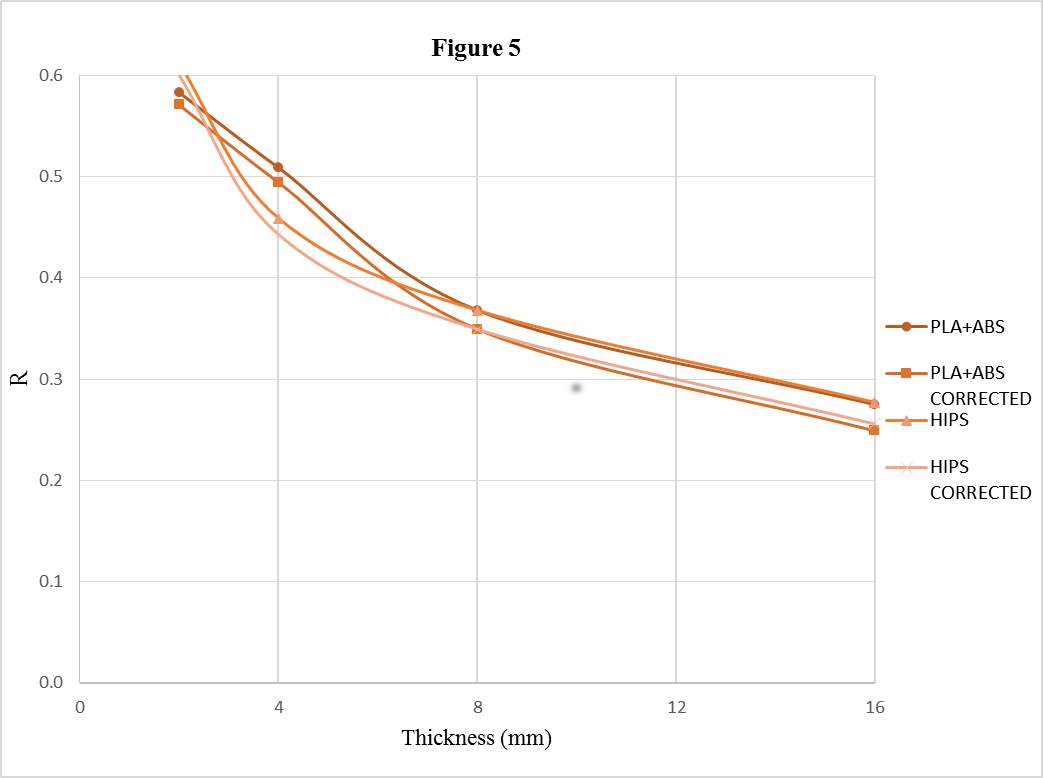
A comparison of the effectiveness of HIPS and a combination of PLA and ABS against aluminum is presented in Figure 4.10, where it can be observed that aluminum is more effective at 2 mm thickness. At 4 mm the plastics are comparable to aluminum.

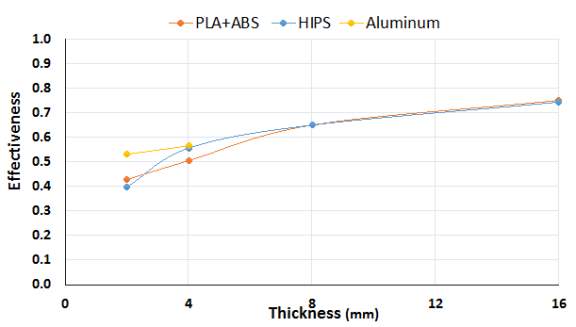
- Comparison of shielding effectiveness of aluminum, HIPS, and a combination of PLA and ABS at different thickness levels
The R value calculations at different thickness levels for HIPS, aluminum and PLA and ABS combined are shown in Table 4.5 below.
| Materials | Thickness (mm) | CPMAvg | CPMAvg
Corrected |
R | R Corrected | Effectiveness |
| PLA | 2 | 261 | 248 | 0.58 | 0.57 | 43% |
| 4 | 230 | 217 | 0.51 | 0.50 | 50% | |
| 8 | 161 | 148 | 0.36 | 0.34 | 66% | |
| ABS | 2 | 265 | 252 | 0.59 | 0.58 | 42% |
| 4 | 229 | 216 | 0.51 | 0.49 | 51% | |
| 8 | 171 | 158 | 0.38 | 0.36 | 64% | |
| PLA+ABS | 2 | 263 | 250 | 0.58 | 0.57 | 43% |
| 4 | 229.5 | 216.5 | 0.51 | 0.49 | 51% | |
| 8 | 166 | 153 | 0.37 | 0.35 | 65% | |
| 16 | 124 | 109 | 0.27 | 0.25 | 75% | |
| HIPS | 2 | 276 | 263 | 0.61 | 0.60 | 40% |
| 4 | 215 | 194 | 0.46 | 0.44 | 56% | |
| 8 | 166 | 153 | 0.37 | 0.35 | 65% | |
| 16 | 125 | 112 | 0.28 | 0.26 | 74% | |
| ALUMINIUM | 2 | – | 205 | – | 0.47 | 53% |
| 4 | – | 190 | – | 0.43 | 57% | |
| CPM0 | 451 | 438 | ||||
In the above table a combination of ABS and PLA is indicated by averaging their CPM counts. For example, for an 8 mm material thickness, the average CPM for ABS (8 mm) was 171 and that for PLA (8 mm) was 161, therefore, the average for the combined material (8 mm) was (171+161)/2 = 166. Since the no shield average CPM was 451, the R value was R = 166/451 = 0.37, indicating that the combined material at 8 mm thickness has an effectiveness of 63% in shielding gamma radiation.
However, this was the uncorrected effectiveness. The corrected average no-shield CPM was 451 – 13 = 438, therefore, the corrected R value was Rc = (166 – 13)/438 = 0.35, indicating that the combined material at 8 mm thickness effectively reduces 65% of incident gamma radiation. Other calculations are similar.
A series of experiments were conducted using different plastic materials at different thickness levels to compare their effectiveness as shielding agents against gamma radiation. Aluminum was the reference material since it is often used in radiation shielding of sensitive electronic components. Results indicate that, although aluminum is more effective at lower thickness of 2 mm, at higher thickness of 4 mm, the plastics exhibit comparable performance. In particular, a combination of ABS and PLA was shown to be 65% effective at a thickness of 8 mm and 75% effective at a thickness of 16 mm against gamma radiation, whereas aluminum was shown to be 53% effective at 2 mm and 57% at 4 mm thickness. Considering these results, PLA at a thickness of 8 mm was chosen as a shield for a high-altitude radiation test (4 mm was too thin and less effective, while 16 mm was too heavy for the payload). Results from this experiment will be discussed in the next chapter.
Cosmic rays are high energy extra-solar particles that bombard the earth travelling at high velocities (often approaching the speed of light) producing secondary radiation showers. Their energies range from few MeV to more than 1020 eV, but only cosmic rays with energies below a few 10s of GeV are significantly affected by the heliosphere. Because all cosmic rays carry an electrical charge, propagation of cosmic rays in the heliosphere is controlled by their interaction with the interplanetary magnetic field. They consist of primary protons and some electrons which react with the upper atmosphere to create protons, and these in turn react with the nuclei of nitrogen atoms in the atmosphere to produce 14C and a proton [41].
One of the interesting phenomena associated with cosmic rays is the terrestrial gamma ray flash (TGF) that was first detected by the Compton Gamma Ray Observatory. Continued observation of these flashes revealed that most of them are associated with lightning discharges, but the relationship between TGFs and lightning storms is still unclear [42]. The flashes have a short duration of 100-500 micro seconds (although some longer than 1 ms have been observed), and it is speculated that they originate from bremsstrahlung interactions of highly accelerated electrons with air that create high energy gamma rays (also known as the relativistic runaway electron avalanche (RREA) process. Monte Carlo simulations of TGFs have shown that their cumulative spectrum is compatible with gamma-rays produced at15-21 km heights above sea level, an altitude compatible with thunder cloud tops [43]. This is approximately the same altitude at which the Pfotzer maximum occurs, which is the region where the highest quantity of ionizing radiation due to cosmic rays occurs. Ionization from cosmic rays reaches its maximum value at altitudes between 17 and 24 km and it has been found to be dependent on geomagnetic latitude [44]. Balloon measurements of charged particle fluxes (greater than 1 MeV) and ion production rates have, in addition, led to a discovery of a correlation between the ratio of ion production rate (q) and the cosmic charged particle flux (J) during days with no solar activity at some polar latitudes [45].
Because of the high energy nature of these events, it has become imperative to find effective means of shielding electronic equipment that frequently flies at these altitudes – for example aboard high altitude planes and balloons. With this objective, a series of experiments were performed using a high altitude balloon in which the shielding behavior of the polymer PLA at 8 mm thickness was observed at the edge of space. The experiments had two primary objectives:
1) Test the shielding effectiveness of PLA (Polylactic Acid) material that was earlier tested on ground using a gamma radiation source. The thickness of the shield is 8 mm (Figure 4.11)
2) Better understand the effect of cosmic radiation fluctuations from the ground into the mid-stratosphere including the Pfotzer maximum where direct observation is yet limited.
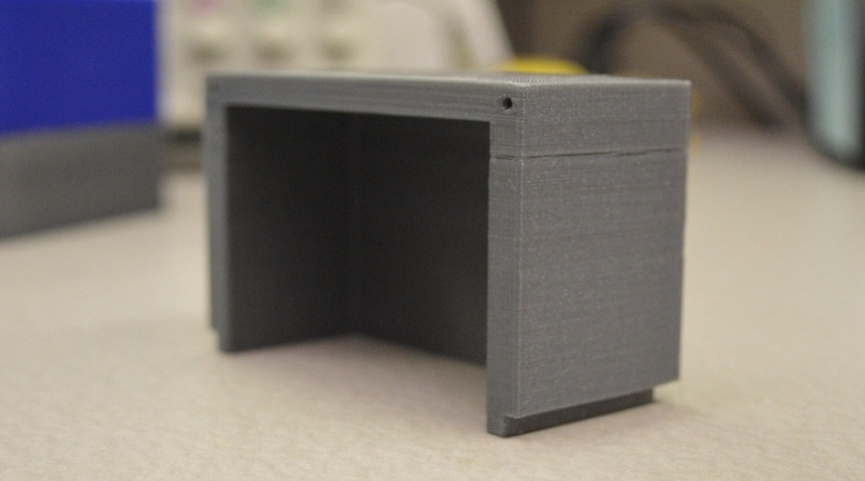
A high-altitude weather balloon, inflated using compressed helium, was used to launch a small payload consisting of assorted scientific equipment –two Geiger counters (GCs) to record atmospheric radiation inside and outside the shield, a temperature sensor, a pressure sensor, SD card, 3 Lithium polymer batteries, heating pads, and a Spot tracker. There were also 3 computers programed using Arduino – one retrieving data from the shielded GC, one retrieving data from the unshielded GC, and the main computer storing all retrieved data to the SD card. The unshielded GC was covered with 8 mm of foam to prevent it from getting wet, and previously it was ascertained that the foam did not noticeably affect its performance. The purpose of this foam was only to protect the GC without blocking any radiation; the other shielded GC did not require the foam cover because the PLA shield itself protected it from environmental conditions. Care was taken to place the heating pads around the area of the Geiger counter board without their obstructing the GC tubes so that any inadvertent shielding from the pads could be avoided. Both GCs were switched on and began counting while on ground approximately 20 minutes prior to the flight. The computer was programmed to switch on the heating pads when external temperature reached 0oC and switch them off at higher temperature.
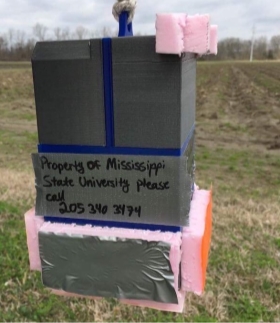
The Spot Tracker was used to ascertain the location of the balloon upon landing while a parachute was attached with the balloon to allow its soft landing. The entire payload was designed in SolidWorks and 3D printed at the department of Aerospace Engineering at Mississippi State University. Pictures of the payload are presented in Figures (4.12 and 4.13).

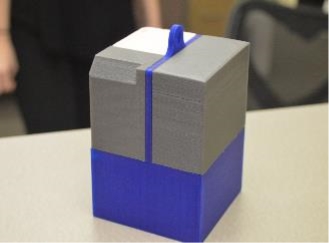
Figure 4.12 (continued)
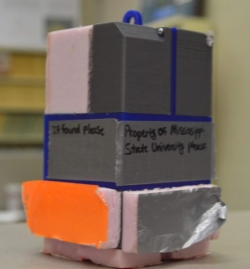
The balloon was launched on February the 16th 2017 at 11:00 am from North Farm in Starkville, MS (33.4504° N, 88.8184° W) and the duration of the flight was approximately 2 hours, with the balloon being chased after launch. Unfortunately, some difficulties were experienced after landing due to which there was a delay of three days in retrieving the payload. It was affected due to rain and bad weather during this period which caused damage to the pressure sensor. Therefore, it was not possible to ascertain the exact altitude of the balloon. In order to overcome this difficulty, an ascent rate of 235 m/min was assumed. This rate would result in attaining the Pfotzer maximum at about the same altitude that other researchers have observed. The heavy payload meant that the ascent rate was lower than the estimate provided by the manufacturer. Pictures of the balloon before and after launch are presented in figures (4.14 and 4.15).
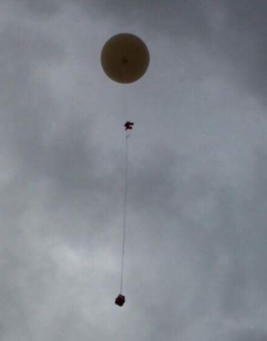
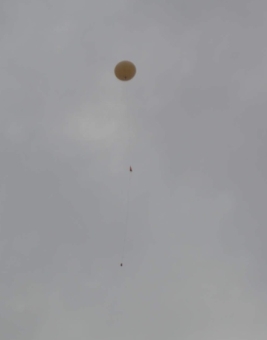

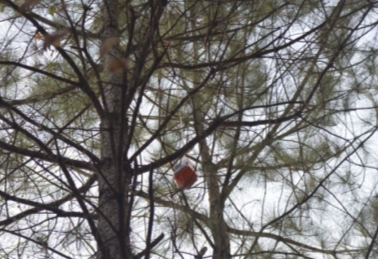
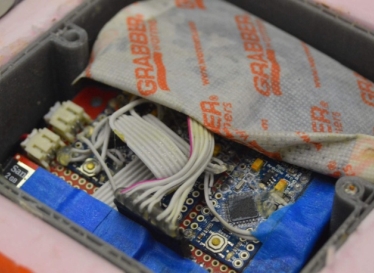
The optimal radiation shielding material and thickness were determined based on the previous experiment. After comparing the effectiveness of aluminum and various plastics, it was found that a combination of PLA and ABS with a thickness of 8 mm was 65% effective against gamma radiation. This was higher than aluminum at 4 mm, which was 57% effective under similar conditions. Considering the cost effectiveness of the plastic and various other factors, such as its flexibility and possibility of sustainable production, the combined plastic material showed promise. It was also observed that ABS and PLA were similar in their effectiveness; in addition, ABS was not available in the laboratory for 3D printing during the balloon experiment. Earlier it was found that PLA at 8 mm thickness has a corrected R value 0.34, giving it an effectiveness of 66% against gamma radiation. Therefore, it was decided to proceed with high altitude shielding experiment with an 8 mm thickness of PLA. Results obtained from the experiment are presented in figures 4.16 and 4.17.
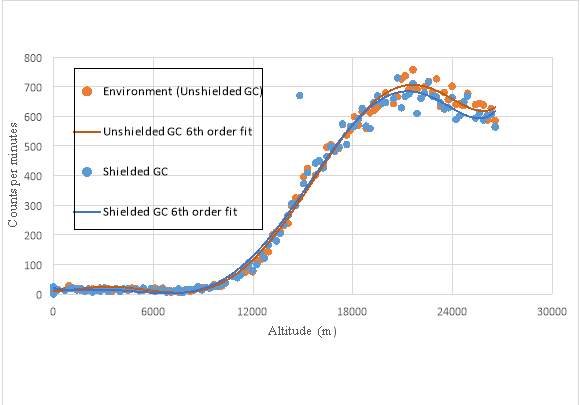
The counts were obtained for the environment using an unshielded GC (red dots) and the shielded GC (blue dots). The series of counts are also approximated using least squares trend lines (6th order fits). The ascent rate, as mentioned earlier, was estimated to be 235 m/min. It can be observed from Figure 4.16 that both trend lines show an upturn above an altitude of 24000 m, but this is taken to be artifact of the fitting procedure. A 10-point running average was used, with the first five points being ignored (since these were not available) and with the number of points per average being successively adjusted at the end of the series. The results are broadly in line with literature, but specific differences may be noted. For example, Carmichael-Coker [46] reported that the highest CPM observed was 4158 at an altitude of 18.7 km, while for the present experiment CPM increased to approximately 725-750 for the unshielded GC and to a lower value of 650-675 at an altitude of approximately 21.5 km.
However, the shape of the curve reported by Carmichael-Coker over the entire range of observations was similar, indicating that although there are individual fluctuating events due to constant fluctuations in the magnetic field and other differences in atmospheric parameters (temperature, airspeed, insolation), overall radiation profiles are similar over a period of time. The shape of the curve reported by Carmichael-Coker is shown in Figure 4.17 below, which is very similar to Figure 4.16.
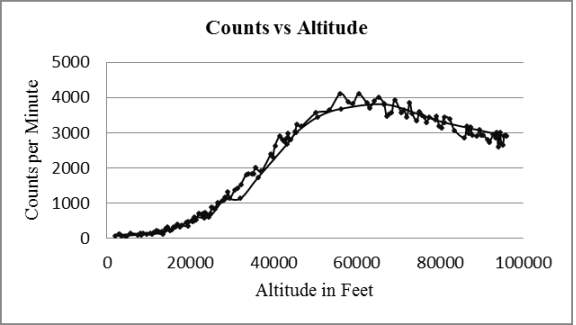
Radiation modeling of the upper atmosphere carried out by Joyce et al. [47] using several different approaches, also yielded comparable results. These authors analyzed the upper atmosphere cosmic radiation environment obtained observationally using the Cosmic Ray Telescope for the Effects of Radiation (CRaTER) module and theoretically using the Badhwar-O’Neil model. Their atmospheric radiation measurements were performed by instruments aboard high-altitude balloons. Knowing the radiation caused by X-rays and gamma ray secondary’s that are emitted as a result of the interaction of the penetrating cosmic rays with the Earth’s atmosphere allowed them to compare how gamma and ionizing radiation varies at different latitudes. They found the Pfotzer maximum to be occurring at a maximum elevation of 36 km while their plotted radiation dose rate (in terms of μGy/hr) for zero atmospheric shielding, corresponding to the pure effect of the magnetosphere on the radiation level, fell below the zero atmospheric level at an altitude of approximately 25 km.
Balloon flights into the atmospheric layer where the Pfotze rmaximum occurs are also being regularly carried out by students of the Earth to Sky Calculus in order to better understand the response of this layer to solar events such as massive flares and storms [48]. Some of these experiments report a radiation level at the Pfotzer maximum that is up to 100 times that on the ground, which is also borne out by the current project – unshielded CPM values were approximately 10-30 on ground and 725-750 at a higher altitude. Continuous monitoring has also shown large variations, particularly as a result of solar storms occurring. More interestingly, observations also revealed significant spatial variations – for example in one experiment it was found that the radiation levels over New Hampshire are approximately 25% more than those above California, for similar elevations [49]. The differences are shown in Figure 4.18 below.
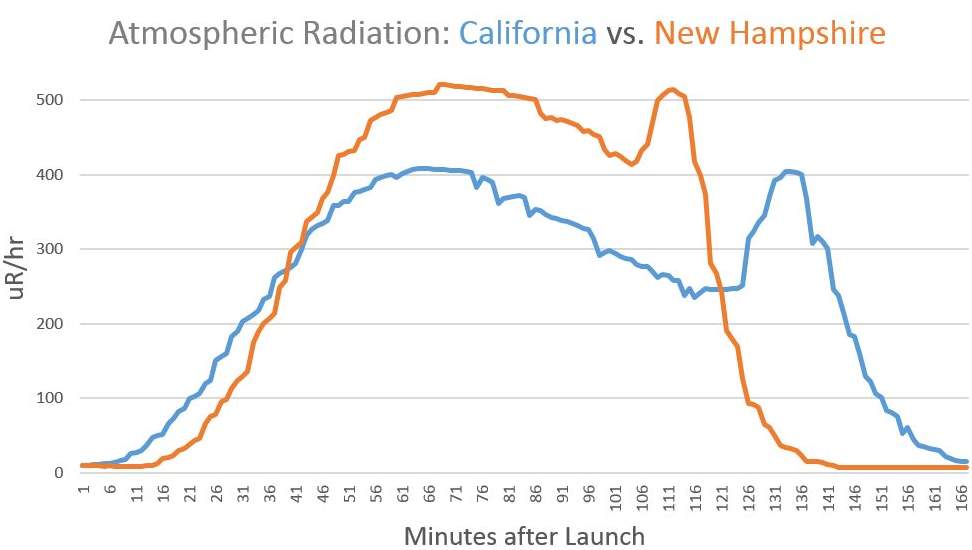
- Atmospheric radiation levels carried out by students of the Earth toCalculus at different latitudes over New Hampshire (+43 N) and California (+37) [49, 50]
This indicates the necessity of many such high-altitude balloon flights, in order to obtain more accurate spatial and temporal maps of the corresponding atmospheric layer at latitudes throughout the world. Since the unshielded counts obtained in the present project are somewhat lower, one reason may be that the ionosphere over Starkville, Mississippi (+33 N) is less ionizing than that over California (+37 N) and New Hampshire (+43) due to its lower latitude. On the other hand, the amount of ionization in the upper atmosphere is believed to be increasing in general due to the current declining phase of the sunspot cycle, which corresponds with an increase in cosmic radiation levels. Balloon flights undertaken by the Earth to Sky Calculus participants indicate a 13% increase in the level of cosmic rays impinging upon the upper atmosphere since March 2015 because of a weakening of the solar magnetic shield.
A different study undertaken found a correlation between atmospheric density and the muon flux (secondary particles that are generated along with neutrinos as a result of nuclear interactions of primary cosmic rays with atmospheric components). It was reported that cosmic rays variations due to both heliosphere differences, and different thermodynamic processes occurring in the upper atmosphere, with barometric effects being a major influence on the detected secondary particle flux [51]. These different studies suggest that the somewhat low CPM count observed during the present project may have resulted from several factors such as location, atmospheric parameters and sunspot activities.
Another objective of the present project was to measure the shielding effectiveness of the chosen material against gamma radiation, and this is explained in Figure 4.19. This shows the observed differences between the unshielded and the shielded CPM counts produced by the respective GCs as a function of altitude. It can be observed that the highest values of the running average (10 point) of the difference between the two counts (indicating highest efficiency of shielding) occur at higher altitudes between 20 km and 24 km, although there are variations due to the expected random nature of the radioactivity process. The running average remains near 0 till approximately 20 km up (indicating no difference due to shielding) and then begins to increase noticeably. This is rather encouraging because the altitude corresponding to Pfotzer maximum is usually avoided by flights – commercial airplanes and other flights usually fly below this altitude while satellites are positioned high above this altitude. The average difference over the entire range of observations was calculated as 6 CPM. The root mean squared deviation between unshielded and shielded CPMs was also calculated and was found to be 38. The average CPM of 6 was calculated using the formula:
CPMavg=1n∑n (CPMenv-CPMshielding)
(4.1)
while the RMSD of 38 was calculated using the formula:
RMSD=1n∑n (CPMenv-CPMshielding)2
(4.2)
This was a large figure, indicating effectiveness of the material as a shielding agent. An earlier study of plastic materials with low Z numbers also observed their effective attenuating behavior against gamma and X radiation, although these experiments were conducted entirely at the ground level [36]. Therefore, it can be observed that the present experiment may be novel in nature, but the results broadly conform to earlier findings.
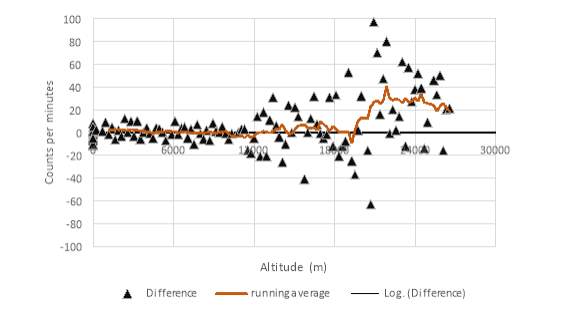
Based on the observations, further high altitude balloon flights should be conducted to better understand the Pfotzer maximum layer, and the identified material should be further tested under different scenarios as a potential commercial shielding agent for electronic equipment flying at the edge of space.
High-energy cosmic rays give rise to a shower of secondary radiation and particles when they interact with the upper layers of the earth’s atmosphere. The intensity of this radiation depends on several factors such as solar activities, which determine the number of impinging cosmic rays, and thermodynamic activities in the atmosphere that affect parameters such as density and temperature at various altitude and latitude levels. As a result, the layer with the highest amount of ionizing radiation, often called the Pfotzer maximum layer, shows considerable variations over different latitudes and at different times of the year. In order to better understand the behavior of this layer and also to test the radiation shielding effectiveness of a PLA layer at 8 mm thickness, a high altitude balloon was flown over Starkville, Mississippi. The balloon contained two GCs, one unshielded and the other shielded. The maximum CPM count for both GCs during this flight was observed at an approximate altitude of 21.5 km with some variations. It is suggested that this may be the approximate location of the Pfotzer maximum layer at the given latitude. In addition, the shielded GC showed lower CPM counts than the unshielded one at higher altitudes (beyond approximately 20 km). This is encouraging because commercial flights avoid flying at these levels due to high levels of radiation. Therefore, considerable gains may be possible if the material is further studied and developed as an effective shielding agent.
A series of experiments were performed using aluminum, ABS and PLA on the ground and in air in order to determine the effectiveness of the plastic materials as alternate radiation shields. The ground experiments used different thicknesses of PLA, ABS and HIPS materials while aluminum was used as the reference material. It was found that the plastic materials did function reasonably well in blocking radiation, although not as well as aluminum for the same thickness. Looked at another way, for the same shielding effectiveness, the plastic must be thicker. This might actually be beneficial since, again for the same shielding effectiveness, the plastic may be lighter than the aluminum, while its greater thickness may make it a better structure.
The airborne experiment was performed with an 8 mm thickness of PLA which was shown to have an effectiveness of 65% against gamma radiation. A small payload was prepared consisting of two Geiger counters, one shielded and the other unshielded (but covered with 8 mm of foam to prevent moisture deposition), and the whole was designed in SolidWorks. A balloon with the payload was launched from Starkville and, apart from landing in a tree, the experiment was conducted successfully. It was found that the Pfotzer maximum layer at the given latitude was located at an approximate altitude of 21.5 km. The PLA shield was demonstrated to be effective in attenuating radiation from cosmic rays, with a sufficiently large RMSD value of 38 between the shielded and the unshielded GCs. Considering the low cost and ease of fabrication of the material, when compared with traditional high Z materials such as lead, aluminum or concrete, the results were significant.
It should be noted, however, that there is as yet inadequate knowledge about the location of the Pfotzer maximum layer at different locations around the world since not many high altitude experiments have been carried out. Balloons have begun to be launched at the required altitudes only recently, as part of experiments conducted by the Earth to Sky Calculus project and other groups, as has been discussed in this report. However, many more such experiments must be launched from different locations in order to obtain a better idea of the spatial and temporal distribution of secondary cascade radiation intensities at higher altitudes. As has been illustrated in this report, there are significant variations of the Pfotzer layer at different latitudes while a number of factors, including solar activity and atmospheric thermodynamics, affect the location of this layer. More experiments have to be launched to properly understand the underlying mechanism of cascade formation at height.
Another open area is the performing of molecular dynamics simulation to better understand computationally the effect of radiation on polymers. Most substances undergo degradation upon irradiation and this affects their effectiveness as radiation shields over longer periods. Since commercial flights and satellites operate for extended durations in hazardous environments and their sensitive electronic equipment are continually subjected to high amounts of radiation, it is imperative that degradation, oxidation and other effects on polymer materials be studied more thoroughly before they can be developed for actual applications. This is especially important in light of the models developed by NASA and other agencies to describe primary cosmic ray bombardment on the outer atmospheric layers [26]. There is a need for performing molecular simulations in conjunction with these particle models.
Cite This Work
To export a reference to this article please select a referencing stye below:
Related Services
View allRelated Content
All TagsContent relating to: "Sciences"
Sciences covers multiple areas of science, including Biology, Chemistry, Physics, and many other disciplines.
Related Articles
DMCA / Removal Request
If you are the original writer of this dissertation and no longer wish to have your work published on the UKDiss.com website then please:




